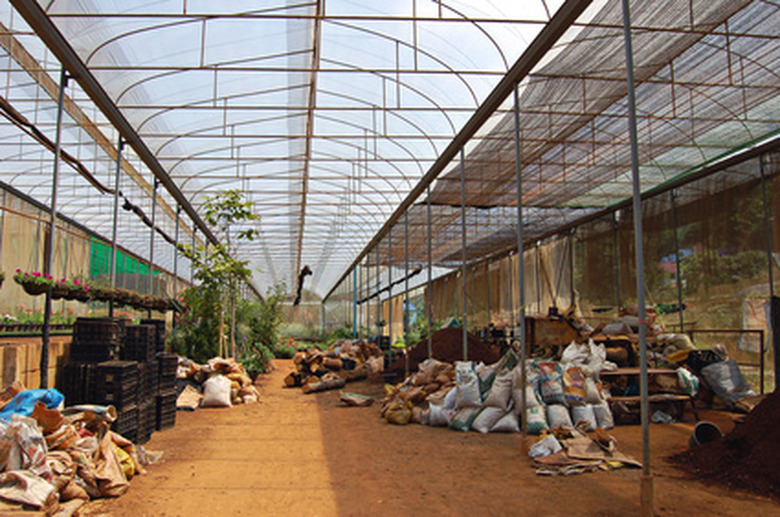Greenhouse Advantages & Disadvantages
Greenhouse gardens have various advantages and disadvantages depending on the gardener's specific needs and requirements. There are also advantages and disadvantages to the type of greenhouse used.
Growing Season
Use greenhouses to extend the growing season. This helps in early planting and late harvesting. Use greenhouses to grow more varieties of vegetation because of the ability to precisely control climate and soil. Greater management is required for greenhouses during off-season months to ensure proper conditions are maintained.
Growing Conditions
Use greenhouses as an advantage for controlling pests and disease. Watch for airborne fungus or bacteria from outside sources, as they can still enter the greenhouse if breezes are allowed into the greenhouse. Precise control of temperature and growing conditions is required for growing vegetation not common to the growing zone. Plant seeds in greenhouses when you want to avoid seeds being blown away or eaten by birds and animals.
- Greenhouse gardens have various advantages and disadvantages depending on the gardener's specific needs and requirements.
- Plant seeds in greenhouses when you want to avoid seeds being blown away or eaten by birds and animals.
Structure
Use glass greenhouses when a long-standing structure is required. Use polyhouses when mobility is favorable, because these are lightweight and easier to move to a new location. Use in-ground gardening where building a structure is not favorable. Greenhouses can be built as part of the residence, so you never leave the house to work in the garden. In-ground gardens are best for integrating into existing landscaping.
Location
Outdoor gardens can be adjusted, adapted and altered according to specific needs whereas greenhouses are more confining once built. Use a greenhouse for areas where in-ground gardening is restrictive or has higher than normal preparation required such as rocky soils, lack of soil or confined spaces. Set greenhouses in open areas where full sunlight can be utilized; greenhouses must have direct sunlight to be effective growing mediums. Zoning requirements may be more restrictive for greenhouses than in-ground gardens because greenhouses are considered buildings and may be subject to building codes.
- Use glass greenhouses when a long-standing structure is required.
- Use polyhouses when mobility is favorable, because these are lightweight and easier to move to a new location.
Maintenance
Greenhouses can require greater maintenance compared to in-ground gardens such as insulation against cold temperatures and strong winds. In-ground gardens require more weed and pest control but can be maintained using mechanical methods while greenhouses require hand weeding and prevention. Greenhouses are more drought resistant than in-ground gardens but can build up temperatures quickly because of confined spaces.
Cost
Building a greenhouse will be more expensive in the initial setup compared to starting a garden on the ground. Growing costs can be extended through a greater time frame using a greenhouse. Costs of seed failure can be higher with in-ground gardens because of uncontrollable environmental conditions. Crop costs can be reduced using a greenhouse because environmental problems can be controlled.
- Greenhouses can require greater maintenance compared to in-ground gardens such as insulation against cold temperatures and strong winds.
Types
Greenhouse building costs can vary greatly because of the materials available. Use polyethylene (polyhouse) greenhouses for lower cost in building and heating. Watch for reduced lighting conditions and increased humidity when using this type of greenhouse compared to a glass greenhouse. Glass framed greenhouses raise the cost of growing. The advantage of glass over polyethylene is the amount of light transmitted through to the crop and the protection from weather; watch for collapse of a polyhouse during severe winter conditions.
